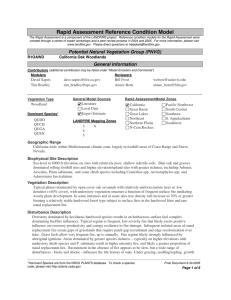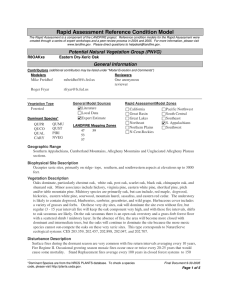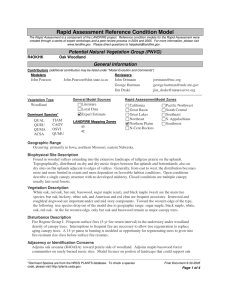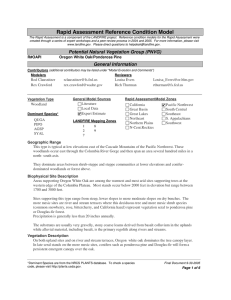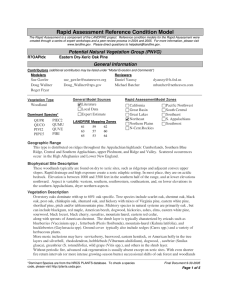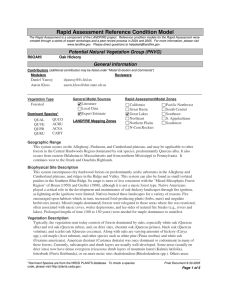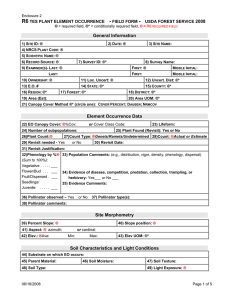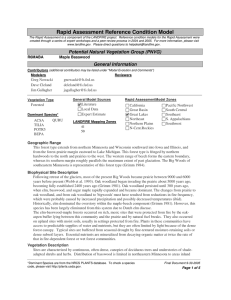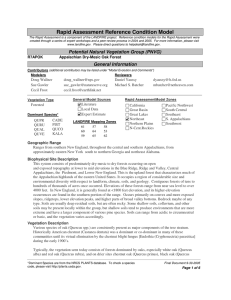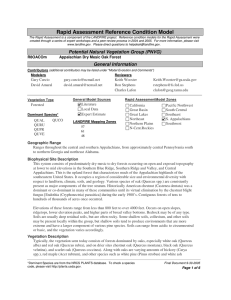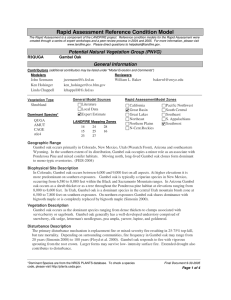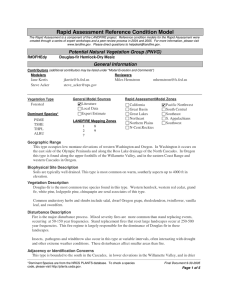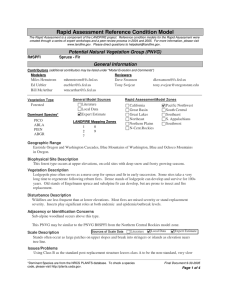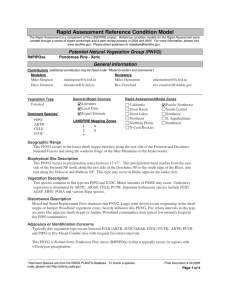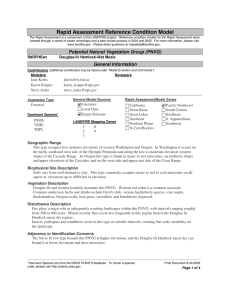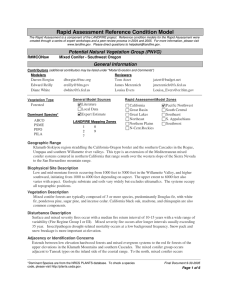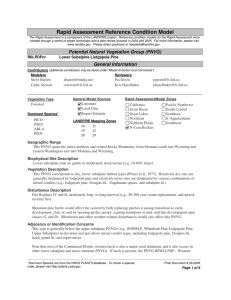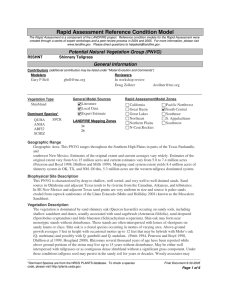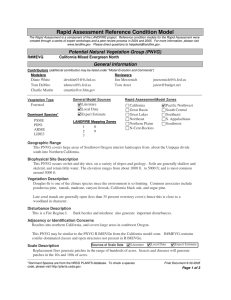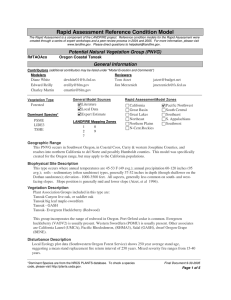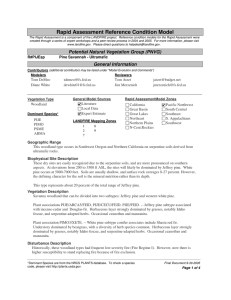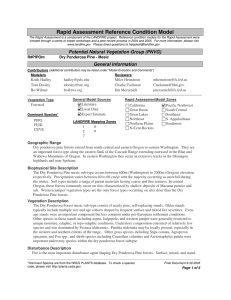Rapid Assessment Reference Condition Model
advertisement
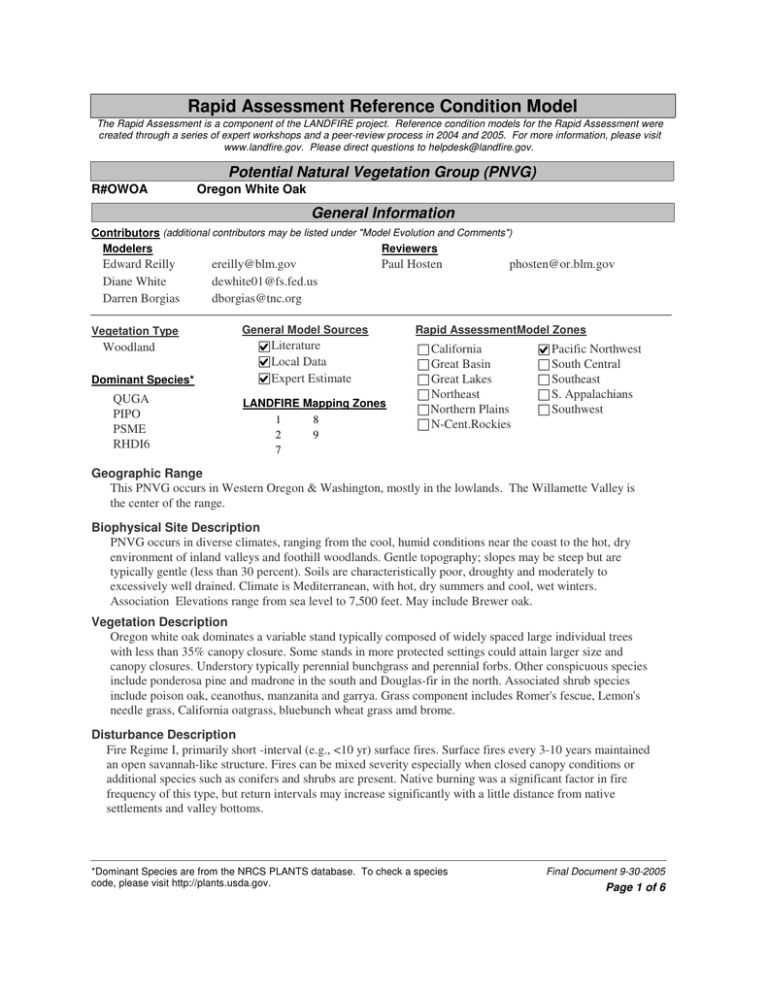
Rapid Assessment Reference Condition Model The Rapid Assessment is a component of the LANDFIRE project. Reference condition models for the Rapid Assessment were created through a series of expert workshops and a peer-review process in 2004 and 2005. For more information, please visit www.landfire.gov. Please direct questions to helpdesk@landfire.gov. R#OWOA Potential Natural Vegetation Group (PNVG) Oregon White Oak General Information Contributors (additional contributors may be listed under "Model Evolution and Comments") Modelers Reviewers Edward Reilly Diane White Darren Borgias Vegetation Type Woodland Dominant Species* QUGA PIPO PSME RHDI6 ereilly@blm.gov dewhite01@fs.fed.us dborgias@tnc.org Paul Hosten General Model Sources Literature Local Data Expert Estimate LANDFIRE Mapping Zones 1 8 2 9 7 phosten@or.blm.gov Rapid AssessmentModel Zones California Great Basin Great Lakes Northeast Northern Plains N-Cent.Rockies Pacific Northwest South Central Southeast S. Appalachians Southwest Geographic Range This PNVG occurs in Western Oregon & Washington, mostly in the lowlands. The Willamette Valley is the center of the range. Biophysical Site Description PNVG occurs in diverse climates, ranging from the cool, humid conditions near the coast to the hot, dry environment of inland valleys and foothill woodlands. Gentle topography; slopes may be steep but are typically gentle (less than 30 percent). Soils are characteristically poor, droughty and moderately to excessively well drained. Climate is Mediterranean, with hot, dry summers and cool, wet winters. Association Elevations range from sea level to 7,500 feet. May include Brewer oak. Vegetation Description Oregon white oak dominates a variable stand typically composed of widely spaced large individual trees with less than 35% canopy closure. Some stands in more protected settings could attain larger size and canopy closures. Understory typically perennial bunchgrass and perennial forbs. Other conspicuous species include ponderosa pine and madrone in the south and Douglas-fir in the north. Associated shrub species include poison oak, ceanothus, manzanita and garrya. Grass component includes Romer's fescue, Lemon's needle grass, California oatgrass, bluebunch wheat grass amd brome. Disturbance Description Fire Regime I, primarily short -interval (e.g., <10 yr) surface fires. Surface fires every 3-10 years maintained an open savannah-like structure. Fires can be mixed severity especially when closed canopy conditions or additional species such as conifers and shrubs are present. Native burning was a significant factor in fire frequency of this type, but return intervals may increase significantly with a little distance from native settlements and valley bottoms. *Dominant Species are from the NRCS PLANTS database. To check a species code, please visit http://plants.usda.gov. Final Document 9-30-2005 Page 1 of 6 Adjacency or Identification Concerns In the south end of the range, Mixed Evergreen or Mixed Conifer may be adjacent. In the absence of frequent fire, ingrowth of both conifer and shrub species often occurs. This PNVG may be similar to the PNVG R1OAWD for the California Model Zone. Local Data Expert Estimate Literature Sources of Scale Data Scale Description The distribution of this type is naturally patchy on the landscape controlled by soil and aspect along with variable incidence of fire. The result is a typically smaller patch size on the order of 100's of acres. Issues/Problems Peer review observed that the model appears to misrepresent the community in SW in regards to oak dominated communities with historically high canopy cover, especially. in SW Oregon (Brewer's oak & transition into chaparral). A description of chaparral as a vegetation type adjacent to SW Oregon oak woodlands is necessary to prevent assumptions that chaparral with an oak component were historically more open. Similarly, naturally high canopy cover Brewer's oak communities that likely experienced stand replacement fire as a norm should also be better described. Poor assumptions about historic condition may lead to fuel reduction/restoration projects that detract from historic conditions, at least in a subset of woodland and adjacent communities in SW Oregon. Model Evolution and Comments This model was originally developed for Southwest Oregon. After meeting with Jane Kertis, it was expanded to include western OR & WA. Reviewers felt it generally encompasses the range of the species well but there are a wide variety of moisture regimes present in the range. Succession Classes** Succession classes are the equivalent of "Vegetation Fuel Classes" as defined in the Interagency FRCC Guidebook (www.frcc.gov). Class A 10 % Early1 PostRep Description Bunchgrass/forb groundcover with resprouting oak and oak saplings following stand replacement fire. Dominant Species* and Canopy Position QUGA4 CECU RHDI CEIN Class B 1% Mid1 Closed Description > 35% canopy cover oak sapling and pole. Cover Height Tree Size Class Upper Layer Lifeform Herbaceous Shrub Tree Fuel Model Min 0% Max 80 % no data no data no data Upper layer lifeform differs from dominant lifeform. Height and cover of dominant lifeform are: no data Dominant Species* and Canopy Position QUGA4 CECU CEIN RHDI Structure Data (for upper layer lifeform) Cover Height Tree Size Class Upper Layer Lifeform Herbaceous Shrub Tree Fuel Model Structure Data (for upper layer lifeform) Min 35 % no data Max 100 % no data no data Upper layer lifeform differs from dominant lifeform. Height and cover of dominant lifeform are: no data *Dominant Species are from the NRCS PLANTS database. To check a species code, please visit http://plants.usda.gov. Final Document 9-30-2005 Page 2 of 6 Class C 20 % Mid1 Open Description < 35% canopy cover sapling and pole oak savanna. Dominant Species* and Canopy Position QUGA4 FERO PIPO DACA3 Cover Height Tree Size Class Upper Layer Lifeform Herbaceous Shrub Tree Fuel Model Class D 64 % Late1 Open Description < 35% large oak savanna. Dominant Species* and Canopy Position QUGA4 FERO PIPO DACA3 Late1 Closed Description >35% canopy cover; mixture of large oak, Douglas-fir, ponderosa pine, incense cedar and/or misc shrub. Tree Size Class Min 0% Max 35 % no data no data no data Upper layer lifeform differs from dominant lifeform. Height and cover of dominant lifeform are: no data Dominant Species* and Canopy Position QUGA4 RHDI PIPO PSME Structure Data (for upper layer lifeform) Cover Height Tree Size Class Upper Layer Lifeform Herbaceous Shrub Tree Fuel Model no data Structure Data (for upper layer lifeform) Height Herbaceous Shrub Tree 5% Max 35 % no data Upper layer lifeform differs from dominant lifeform. Height and cover of dominant lifeform are: Cover Fuel Model Min 0% no data no data Upper Layer Lifeform Class E Structure Data (for upper layer lifeform) Min 35 % no data Max 100 % no data no data Upper layer lifeform differs from dominant lifeform. Height and cover of dominant lifeform are: no data Disturbances *Dominant Species are from the NRCS PLANTS database. To check a species code, please visit http://plants.usda.gov. Final Document 9-30-2005 Page 3 of 6 Disturbances Modeled Fire Insects/Disease Wind/Weather/Stress Native Grazing Competition Other: Other Historical Fire Size (acres) Avg: no data Min: no data Max: no data Sources of Fire Regime Data Literature Local Data Expert Estimate Fire Regime Group: 1 I: 0-35 year frequency, low and mixed severity II: 0-35 year frequency, replacement severity III: 35-200 year frequency, low and mixed severity IV: 35-200 year frequency, replacement severity V: 200+ year frequency, replacement severity Fire Intervals (FI) Fire interval is expressed in years for each fire severity class and for all types of fire combined (All Fires). Average FI is central tendency modeled. Minimum and maximum show the relative range of fire intervals, if known. Probability is the inverse of fire interval in years and is used in reference condition modeling. Percent of all fires is the percent of all fires in that severity class. All values are estimates and not precise. Avg FI Replacement Mixed Surface All Fires Min FI 275 50 12.5 10 Max FI Probability Percent of All Fires 0.00364 0.02 0.08 0.10364 4 19 77 References Agee, James K. 1991. Fire History along an elevational gradient in the Siskiyou Mountains, Oregon. Northwest Science. 65(4): 188-199. Arno, Stephen F. 2000. Fire in western forest ecosystems. In: Brown, James K.; Smith, Jane Kapler, eds. Wildland fire in ecosystems: Effects of fire on flora. Gen. Tech. Rep. RMRS-GTR-42-vol. 2. Ogden, UT: U.S. Department of Agriculture, Forest Service, Rocky Mountain Research Station: 97-120 Atzet, Thomas; McCrimmon, Lisa A. 1990. Preliminary plant associations of the southern Oregon Cascade Mountain Province. Grants Pass, OR: U.S. Department of Agriculture, Forest Service, Siskiyou National Forest. 330 p. Barbour, Michael G. 1988. Californian upland forests and woodlands. In: Barbour, Michael G.; Billings, William Dwight, eds. North American terrestrial vegetation. Cambridge; New York: Cambridge University Press: 131-164. Barnhardt, Stephen J.; McBride, Joe R.; Cicero, Carla; [and others]. 1987. Vegetation dynamics of the northern oak woodland. In: Plumb, Timothy R.; Pillsbury, Norman H., technical coordinators. Proceedings of the symposium on multiple-use management of California's hardwood resources; 1986 November 12-14; San Luis Obispo, CA. Gen. Tech. Rep. PSW-100. Berkeley, CA: U.S. Department of Agriculture, Forest Service, Pacific Southwest Forest and Range Experiment Station: 53-58. Brown, James K.; Smith, Jane Kapler, eds. 2000. Wildland fire in ecosystems: effects of fire on flora. Gen. Tech. Rep. RMRS-GTR-42-vol. 2. Ogden, UT: U.S. Department of Agriculture, Forest Service, Rocky Mountain Research Station. 257 p. Chang, Chi-Ru. 1996. Ecosystem responses to fire and variations in fire regimes. In: Sierra Nevada Ecosystem Project: Final report to Congress, vol. II, Assessments and scientific basis for management options, Chapter 39. Davis, University of California, Centers for Water and Wildand Resources. Pp. 10711099. Eyre, F. H., ed. 1980. Forest cover types of the United States and Canada. Washington, DC: Society of *Dominant Species are from the NRCS PLANTS database. To check a species code, please visit http://plants.usda.gov. Final Document 9-30-2005 Page 4 of 6 American Foresters. 148 p. Griffin, James R. 1977. Oak woodland. In: Barbour, Michael G.; Malor, Jack, eds. Terrestrial Vegetation of California. New York: John Wiley and Sons: 383-415. Habeck, James R. 1961. The original vegetation of the mid-Willamette Valley, Oregon. Northwest Science. 35: 65-77. Hardy, Colin C., Kirsten M. Schmidt, James P. Menakis, R. Neil Samson. 2001. Spatial data for national fire planning and fuel management. Int. J. Wildland Fire. 10(3&4): 353-372. Hickman, J.C. (ed). 1993. Jepson Manual: Higher plants of California. Berkeley, CA; University of California Press. 1400 pp. Howard, Janet L. Quercus garryana. In: Fire Effects Information System, [Online]. U.S. Department of Agriculture, Forest Service, Rocky Mountain Research Station, Fire Sciences Laboratory (Producer). Available: http://www.fs.fed.us/database/feis/ [2004, November 29]. Kilgore, Bruce M. 1981. Fire in ecosystem distribution and structure: western forests and scrublands. In: Mooney, H. A.; Bonnicksen, T. M.; Christensen, N. L.; [and others], technical coordinators. Proceedings of the conference: Fire regimes and ecosystem properties; 1978 December 11-15; Honolulu, HI. Gen. Tech. Rep. WO-26. Washington, DC: U.S. Department of Agriculture, Forest Service: 58-89. Kuchler, A. W. 1964. Manual to accompany the map of potential vegetation of the conterminous United States. Special Publication No. 36. New York: American Geographical Society. 77 p. McDonald, Philip M.; Minore, Don; Atzet, Tom. 1983. Southwestern Oregon-- northern California hardwoods. In: Burns, Russel M., compiler. Silvicultural systems for the major forest types of the United States. Agric. Handb. 445. Washington, DC: U.S. Department of Agriculture: 29-32. Muick, Pamela C.; Bartolome, James W. 1987. Factors associated with oak regeneration in California. In: Plumb, Timothy R.; Pillsbury, Norman H., technical coordinators. Proceedings of the symposium on multipleuse management of California's hardwood resources; 1986 November 12-14; San Luis Obispo, CA. Gen. Tech. Rep. PSW-100. Berkeley, CA: U.S. Department of Agriculture, Forest Service, Pacific Southwest Forest and Range Experiment Station: 86-91. Reed, Lois J.; Sugihara, Neil G. 1987. Northern oak woodlands—ecosystem in jeopardy or is it already too late?. In: Plumb, Timothy R.; Pillsbury, Norman H., technical coordinators. Proceedings of the symposium on multiple-use management of California's hardwood resources; 1986 November 12-14; San Luis Obispo, CA. Gen. Tech. Rep. PSW-100. Berkeley, CA: U.S. Department of Agriculture, Forest Service, Pacific Southwest Forest and Range Experiment Station: 59-63. Riegel, Gregg M.; Smith, Bradley G.; Franklin, Jerry F. 1992. Foothill oak woodlands of the interior valleys of southwestern Oregon. Northwest Science. 66(2): 66-76. Schmidt, Kirsten M, Menakis, James P., Hardy, Colin C., Hann, Wendel J., Bunnell, David L. 2002. Development of coarse-scale spatial data for wildland fire and fuel management. Gen. Tech. Rep. RMRSGTR-87. Fort Collins, CO: U.S. Department of Agriculture, Forest Service, Rocky Mountain Research Station. 41 p. + CD. Sensenig, Thomas. 2002. Development, Fire History, and Current and Past Growth of Old-Growth and YoungGrowth Forest Stands in the Cascade, Siskiyou and Mid-Coast Mountains of Southwestern Oregon Ph.D. Thesis, Oregon State University, Corvallis. *Dominant Species are from the NRCS PLANTS database. To check a species code, please visit http://plants.usda.gov. Final Document 9-30-2005 Page 5 of 6 Smith, Winston Paul. 1985. Plant associations within the interior valleys of the Umpqua River Basin, Oregon. Journal of Range Management. 38(6): 526-530. Thilenius, John F. 1968. The Quercus garryana forests of the Willamette Valley, Oregon. Ecology. 49(6): 1124-1133 Thorne, Robert F. 1976. The vascular plant communities of California. In: Latting, June, ed. Symposium proceedings: plant communities of southern California; 1974 May 4; Fullerton, CA. Special Publication No. 2. Berkeley, CA: California Native Plant Society: 1-31. [3289] Vogl, Richard J. 1977. Fire frequency and site degradation. In: Mooney, Harold A.; Conrad, C. Eugene, technical coordinators. Proc. Of the symp. On the environmental consequences of fire and fuel management in Mediterranean ecosystems; 1977 August 1-5; Palo Alto, CA. Gen. Tech. Rep. WO-3. Washington, DC: U.S. Department of Agriculture, Forest Service: 193-201. *Dominant Species are from the NRCS PLANTS database. To check a species code, please visit http://plants.usda.gov. Final Document 9-30-2005 Page 6 of 6
